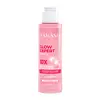What's inside
What's inside
 Key Ingredients
Key Ingredients

No key ingredients
 Benefits
Benefits

 Concerns
Concerns

 Ingredients Side-by-side
Ingredients Side-by-side

Water
Skin ConditioningNiacinamide
SmoothingHydroxyethyl Urea
HumectantBetaine
HumectantTrehalose
HumectantPhenoxyethanol
PreservativeGlycerin
HumectantAcetyl Glycyl Beta-Alanine
Skin ConditioningBiosaccharide Gum-1
HumectantButylene Glycol
HumectantPropanediol
SolventGlycereth-26
HumectantCentella Asiatica Extract
CleansingPropylene Glycol
HumectantAllantoin
Skin ConditioningMandelic Acid
AntimicrobialPanthenol
Skin ConditioningPolyacrylate Crosspolymer-6
Emulsion StabilisingEthylhexylglycerin
Skin ConditioningDisodium EDTA
1,2-Hexanediol
Skin ConditioningSodium Hyaluronate
HumectantPentylene Glycol
Skin ConditioningSchizophyllan
HumectantHyaluronic Acid
HumectantHydrolyzed Hyaluronic Acid
HumectantHydrolyzed Sodium Hyaluronate
Skin ConditioningHydroxypropyltrimonium Hyaluronate
Potassium Hyaluronate
Skin ConditioningSodium Acetylated Hyaluronate
HumectantSodium Hyaluronate Crosspolymer
HumectantWater, Niacinamide, Hydroxyethyl Urea, Betaine, Trehalose, Phenoxyethanol, Glycerin, Acetyl Glycyl Beta-Alanine, Biosaccharide Gum-1, Butylene Glycol, Propanediol, Glycereth-26, Centella Asiatica Extract, Propylene Glycol, Allantoin, Mandelic Acid, Panthenol, Polyacrylate Crosspolymer-6, Ethylhexylglycerin, Disodium EDTA, 1,2-Hexanediol, Sodium Hyaluronate, Pentylene Glycol, Schizophyllan, Hyaluronic Acid, Hydrolyzed Hyaluronic Acid, Hydrolyzed Sodium Hyaluronate, Hydroxypropyltrimonium Hyaluronate, Potassium Hyaluronate, Sodium Acetylated Hyaluronate, Sodium Hyaluronate Crosspolymer
Water
Skin ConditioningAcrylates Copolymer
Cocamidopropyl Betaine
CleansingPropylene Glycol
HumectantGlycerin
HumectantSodium Lauroyl Sarcosinate
CleansingDecyl Glucoside
CleansingSodium PCA
HumectantPotassium Cocoyl Glycinate
Sodium Laureth Sulfate
CleansingPotassium Cocoate
EmulsifyingSodium Chloride
MaskingPhenoxyethanol
PreservativeSodium Hydroxide
BufferingDMDM Hydantoin
PreservativeEthylhexylglycerin
Skin ConditioningDisodium EDTA
Aloe Barbadensis Leaf Extract
EmollientPotassium Sorbate
PreservativeSodium Benzoate
MaskingWater, Acrylates Copolymer, Cocamidopropyl Betaine, Propylene Glycol, Glycerin, Sodium Lauroyl Sarcosinate, Decyl Glucoside, Sodium PCA, Potassium Cocoyl Glycinate, Sodium Laureth Sulfate, Potassium Cocoate, Sodium Chloride, Phenoxyethanol, Sodium Hydroxide, DMDM Hydantoin, Ethylhexylglycerin, Disodium EDTA, Aloe Barbadensis Leaf Extract, Potassium Sorbate, Sodium Benzoate
Ingredients Explained
These ingredients are found in both products.
Ingredients higher up in an ingredient list are typically present in a larger amount.
Disodium EDTA plays a role in making products more stable by aiding other preservatives.
It is a chelating agent, meaning it neutralizes metal ions that may be found in a product.
Disodium EDTA is a salt of edetic acid and is found to be safe in cosmetic ingredients.
Learn more about Disodium EDTAEthylhexylglycerin (we can't pronounce this either) is commonly used as a preservative and skin softener. It is derived from glyceryl.
You might see Ethylhexylglycerin often paired with other preservatives such as phenoxyethanol. Ethylhexylglycerin has been found to increase the effectiveness of these other preservatives.
Glycerin is already naturally found in your skin. It helps moisturize and protect your skin.
A study from 2016 found glycerin to be more effective as a humectant than AHAs and hyaluronic acid.
As a humectant, it helps the skin stay hydrated by pulling moisture to your skin. The low molecular weight of glycerin allows it to pull moisture into the deeper layers of your skin.
Hydrated skin improves your skin barrier; Your skin barrier helps protect against irritants and bacteria.
Glycerin has also been found to have antimicrobial and antiviral properties. Due to these properties, glycerin is often used in wound and burn treatments.
In cosmetics, glycerin is usually derived from plants such as soybean or palm. However, it can also be sourced from animals, such as tallow or animal fat.
This ingredient is organic, colorless, odorless, and non-toxic.
Glycerin is the name for this ingredient in American English. British English uses Glycerol/Glycerine.
Learn more about GlycerinPhenoxyethanol is a preservative that has germicide, antimicrobial, and aromatic properties. Studies show that phenoxyethanol can prevent microbial growth. By itself, it has a scent that is similar to that of a rose.
It's often used in formulations along with Caprylyl Glycol to preserve the shelf life of products.
Propylene Glycol is an odorless, colorless liquid. As a humectant, it helps skin retain moisture. It also aids in delivering active ingredients.
Another role of this ingredient is preventing a product from melting or freezing. Propylene glycol also adds antimicrobrial properties to a product, elongating product lifespan.
This ingredient is considered an organic alcohol and commonly added into both cosmetics and foods.
Those with sensitive skin or conditions may develop a rash when using this ingredient.
Learn more about Propylene GlycolWater. It's the most common cosmetic ingredient of all. You'll usually see it at the top of ingredient lists, meaning that it makes up the largest part of the product.
So why is it so popular? Water most often acts as a solvent - this means that it helps dissolve other ingredients into the formulation.
You'll also recognize water as that liquid we all need to stay alive. If you see this, drink a glass of water. Stay hydrated!
Learn more about Water